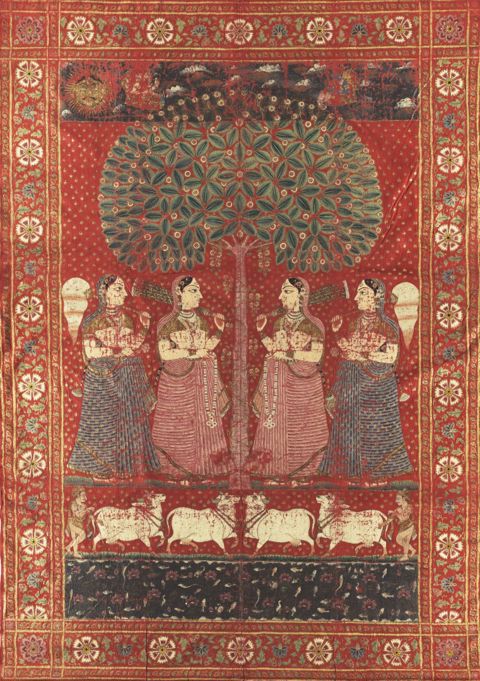“Woven Wonders: Indian Textiles from the Parpia Collection” to Be Presented at the MFAH This Summer

Golconda Picchwai, Pichwal, 18th century, painted textile, the Banoo and Jeevak Parpia Collection.
Bengal, Alternative Kantha, Playful and Colorful Abstract, early 20th century, cotton ground with cotton embroidery, the Banoo and Jeevak Parpia Collection.
Indian Coromandel Coast, Palampore, 18th century, cotton (plain weave), hand-drawn, mordant-dyed and resist-dyed, the Banoo and Jeevak Parpia Collection.
Rajasthan Shekawati, Bandhani Turban Cloth, 19th century, bandhani, the Banoo and Jeevak Parpia Collection.
Bengal, Large Kantha, Domestic Embroidery Done by a Woman, late 19th–early 20th century, embroidered textile, the Banoo and Jeevak Parpia Collection.
Featuring 80 textiles spanning the 14th to the early 20th century that convey the preeminence of textile arts produced in India over 600 years
HOUSTON—March 8, 2023—A selection from one of the most significant private collections of Indian textiles outside of India will be on view at the Museum of Fine Arts, Houston, from June 10 through September 4, 2023. From folk textiles to the most sophisticated court textiles, produced from the 14th to early 20th century, the collection of Banoo and Jeevak Parpia illustrates the preeminence of textile arts produced in India over 600 years.
“The Museum of Fine Arts, Houston, has a long-standing commitment to the arts of India,” commented Gary Tinterow, MFAH Director and Margaret Alkek Williams Chair. “Banoo and Jeevak Parpia have over recent years brought their insight and expertise to programs and to our collections of textiles from India. With this exhibition from their exceptional collection, we will be able to further our representation of the rich cultural heritage of Houston’s South Asian community, while exploring the history of one of India’s most treasured art forms.”
Co-curator Amy Poster, Consulting Curator at the MFAH, noted, “Seldom are collections of Indian textiles as comprehensive, or collected with such expertise. Assembled to reflect the myriad range of regional traditions, the Parpia Collection includes many singular pieces that reflect the extraordinary aesthetic and technical diversity of Indian textiles, from folk weavings to the most sophisticated court textiles.”
India was among the earliest sources of fine cotton and silk textiles, and has produced some of the world’s most innovative textile traditions. The broad range of techniques, including painting, block printing, ikat, tie-dye, brocade, tapestry, and embroidery, reflects the diversity of regional textile production within India. Rich variations in ornamentation reflect the varied social and cultural contexts for which these textiles were made, including Hindu devotional practices, Islamic court textiles, and pieces made for domestic use.
The exhibition Woven Wonders: Indian Textiles from the Parpia Collection also explores the patterns and dynamics of 500 years of the prosperous maritime trade that supplied Indian textiles to Southeast Asia, Europe, and Japan. Initially led by Arab, Persian, and Indian merchants, that trade was later dominated by Portuguese, Dutch, and British traders who bartered Indian textiles for spices in Southeast Asia, and who expanded the market for Indian chintz and embroideries in Asia and Europe. Reflecting this shift in demand, early pieces in the exhibition produced for trade with Indonesia in the 14th to 16th centuries were treasured and preserved as heirlooms. Later textiles made for specific markets, such as Thailand, Sri Lanka, and Europe, show how textile designers and makers tailored fabrics for foreign tastes. Luxury textiles made for royal patrons in the 17th to 19th century display some of the finest-quality weaving, dyeing, and embroidery designs and techniques, executed to an exceptional level of sophistication.
Organization and Funding
Woven Wonders: Indian Textiles from the Parpia Collection is organized by the Museum of Fine Arts, Houston, and co-curated by Amy Poster, Consulting Curator, MFAH, and Rosemary Crill, former Senior Curator at the Victoria & Albert Museum, London.
Lead Underwriters:
The Sushila and Dr. Durga D. Agrawal Family
Generous support provided by:
Sesh and Prabha Bala
Milton D. Rosenau, Jr. and Dr. Ellen R. Gritz
Chitra Kumar and Kumar Bashyam
Paul and Manmeet Likhari
Nidhika and Pershant Mehta
Drs. Kumara and Usha Peddamatham
Special exhibition programming is made possible by The Medha and Shashank Karve Endowment Fund.
About Banoo and Jeevak Parpia
Ithaca, New York–based collectors Banoo and Jeevak Parpia have been collecting textiles from India since the 1980s. Banoo Parpia has recently retired as director of development for Asia at Cornell University. Jeevak Parpia is a professor of physics at Cornell University, with a research focus on experimental atomic and condensed-matter physics.
About the Museum of Fine Arts, Houston
Spanning 14 acres in the heart of Houston’s Museum District, the main campus comprises the Audrey Jones Beck Building, the Caroline Wiess Law Building, the Lillie and Hugh Roy Cullen Sculpture Garden and the Nancy and Rich Kinder Building. Nearby, two house museums—Bayou Bend Collection and Gardens, and Rienzi—present collections of American and European decorative arts. The MFAH is also home to the Glassell School of Art, with its Core Residency Program and Junior and Studio schools; and the International Center for the Arts of the Americas (ICAA), a leading research institute for 20th-century Latin American and Latino art. www.mfah.org
Media Contact
Melanie Fahey, Senior Publicist, MFAH
mfahey@mfah.org | 713.398.1136
